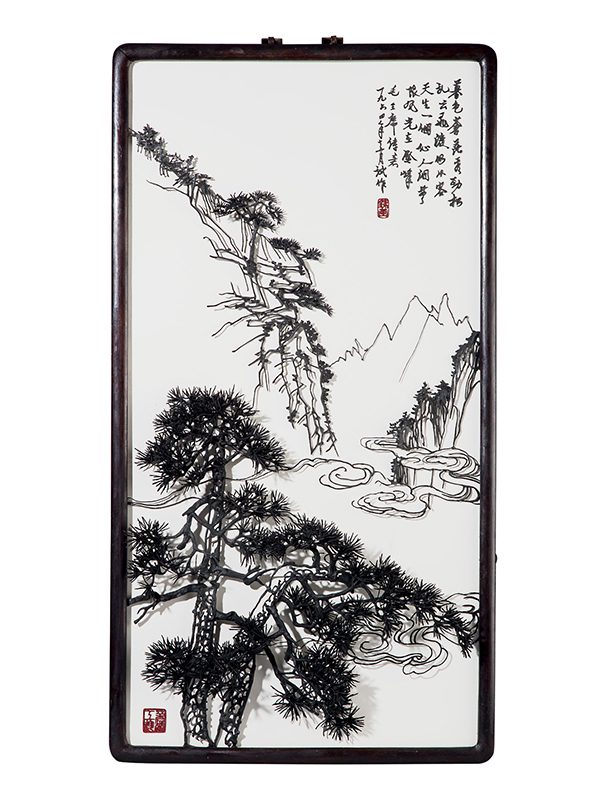Iron painting tiehua
An iron painting depicting a landscape with a setting of pine trees growing from the edges of cliffs among clouds. The foreground has two large, dense pine trees. The upper right-hand corner is inscribed with a poem written by Chairman Mao Zedong, after an inscription stating that this iron painting was created in December 1964. A rectangular mark in red at the end of the inscription reads Tie Hua (iron painting). The lower left corner of the painting has another mark in red in a square, imitating a seal stamp, reading Wu Hu Gong Yi (‘crafts from Wuhu’). The landscape, inscriptions and marks are all made as wrought iron elements, which are crafted individually and joined together with bolts. The painting is contained within a hardwood frame.
The contrast in this iron painting between the dark iron and the lighter background results in a striking two-dimensional equivalent of ink painting. The art of iron painting was developed in Wuhu city of Anhui province in the late 17th century. According to Jenyns and Watson: “…Tang Tien-chih, an iron worker, set the example by vying with the painter Hsiao Yun-tsung in depicting landscape.”[1] The subject matter depicted here echoes the poem inscribed on the upper right-hand corner. The poem, consisting of four phrases with seven Chinese characters each (known as Qijue), can be translated as follows “Amid the growing shades of dusk stand sturdy pines/ Riotous clouds sweep past, swift and tranquil/ Nature has excelled herself in the Fairy Cave/ On perilous peaks dwells beauty in her infinite variety.” This poem was written by Chairman Mao Zedong (1893 – 1976) on 9th September 1961, with the title ‘The Fairy Cave – Inscription on a Picture Taken by Comrade Li Jin – a Qijue’; it was first published in The Poems of Mao Zedong in 1963. The title refers to a poem written for a photograph taken by Li Jin, also known as Jiang Qing (1914 – 1991), the fourth wife of Mao. The pine tree enhances the scholarly theme, as it is a symbol of longevity. There are only two sets of iron paintings that are attributed to Tang Tien-chih, the creator of this type of artworks: a set of four depicting flowers and birds of four seasons is in the collection of the Palace Museum, Beijing.[2] Another example depicting a Chinese landscape is in the collection of the Zhenjiang Museum.[3] There are two further comparable sets: four 18th century iron paintings representing the seasons are in the collection of the British Museum.[4] Four further comparable iron paintings dated to the 17th century were included in the exhibition, The Chinese Scholar’s Studio: Artistic Life in the Late Ming Period from the Shanghai Museum in 1987.[5]
Provenance: private collection, Ireland
- Jenyns, R.S. and Watson, W. Chinese Art, Vol. II, Phaidon, Oxford, 1980, p. 104
- Guojia wenwu ju ed. Illustrated Important Chinese Cultural Relics Ranking Standard- Furniture, Beijing, Wenwu chubanshe, 2009, no. 59, p. 113
- The Zhenjiang Museum online collection archive, http://www.zjmuseum.com.cn/zjbwg/zjbwg/zs/jpww/ gyp/2016/10/27/0b609a9a57fc12f0015804305026081a.html
- Jenyns, R.S. and Watson, W. op. cit., p.104
- Li, C. T. and Watt, J. C.Y. eds, The Chinese Scholar’s Studio: Artistic Life in the Late Ming Period-An Exhibition from the Shanghai Museum, Thames and Hudson, New York, 1987, pp. 120-121, no. 68
鐵畫 《七絕·為李進同志題所攝廬山仙人洞照》
民國 1964年 高:84.5 公分 寬:45.5 公分
長方形鐵畫,裱於木框。畫面左下半部飾以蒼鬱勁松,枝幹挺立,針葉茂密張揚。後襯遠景山崖
陡峭,雲氣托山,惟松林仍屹立騎上,恣意蔓延。右上方題詩一首:「暮色蒼茫看勁松,亂雲飛
渡仍從容。天生一個仙人洞,無限風光在險峰。」再書「毛主席詩詞,一九六四年試作。」此首
《七絕·為李進同志題所攝廬山仙人洞照》是毛澤東1961年9月9日為江青(即李進)拍攝的照
片所寫,最早發表於人民文學出版社1963年12月版的《毛主席詩詞》裡。仙人洞,在廬山佛手岩
下,牯岭之西,高約兩丈,深廣各三四丈,傳為唐朝仙人呂洞賓所居,故名。本詩通過對勁松和
仙人洞的生動描寫,寓理於景。此幅鐵畫則以精湛工藝,以鐵為墨,以砧為紙,鍛鐵為畫,細膩
重現出詩中深遠寓意,氣韻生動。提辭下方嵌「鐵畫」朱書長方款,畫面左下角嵌「蕪湖工藝」
朱書方款,指明本畫自安徽蕪湖出品。安徽蕪湖鐵畫於清康熙年間自成一體,至今工藝仍享譽國
際,鍛製技藝於2006年經中國國務院批准列入第一批國家級非物質文化遺產名錄。這件作品詩畫
藝兼備,定年確切,實為難得。北京故宮、大英博物館與上海博物館皆有蕪湖鐵畫收藏。
來源:愛爾蘭私人收藏

